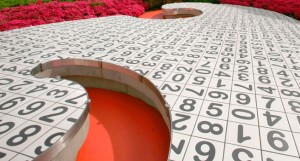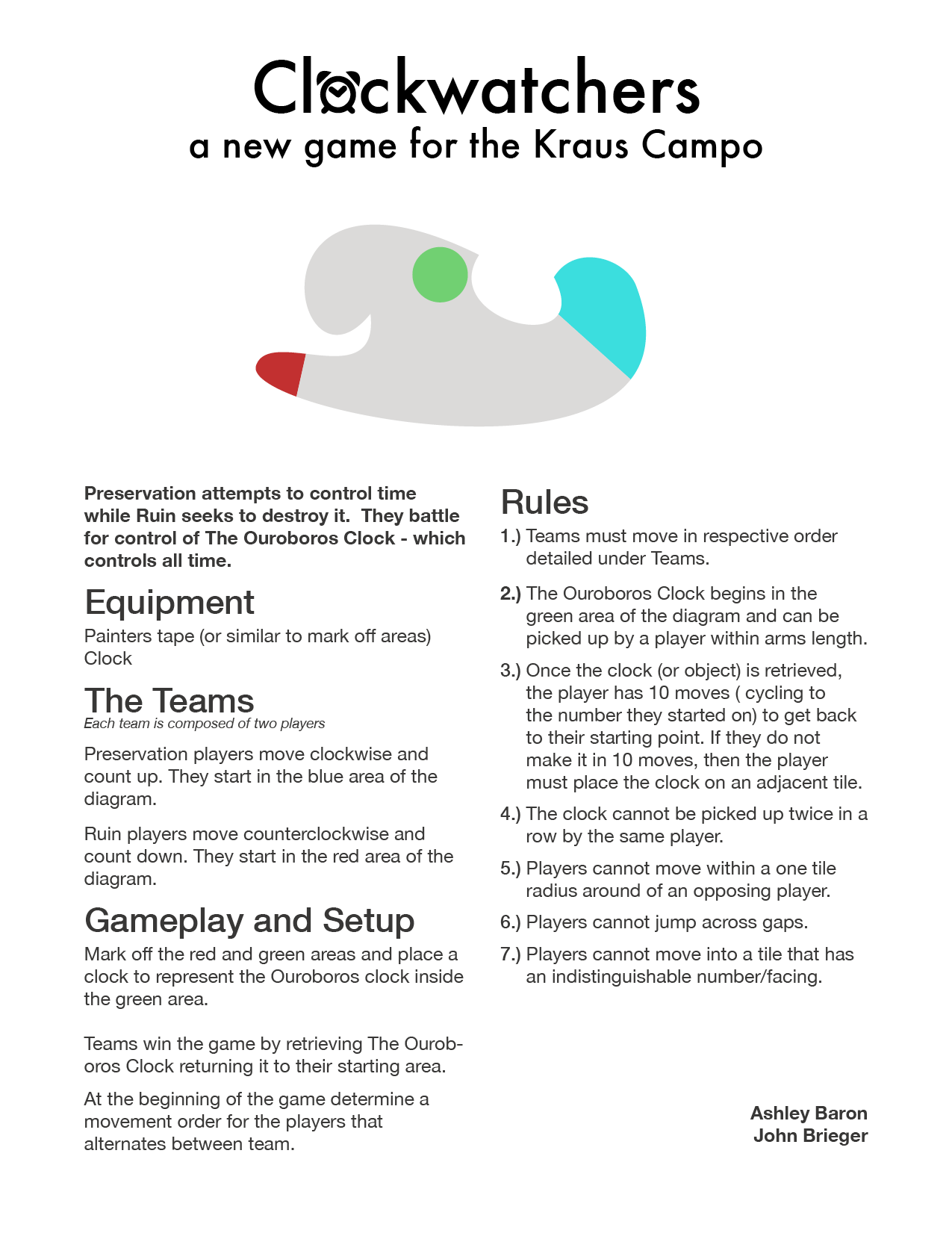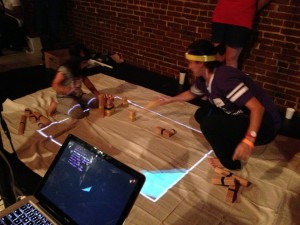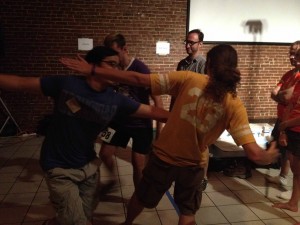Premise:
Win the game, but don’t get caught trying.
Necessities:
- A stack of game cards (easily printed out)
- Paper balls (easily crumpled)
- The Number Garden
- 10+ Players
Setup:
- Give each player a game card
- Players are to keep their cards secret!
- The game card will give the player’s role
Player Roles:
- For Race: either Robot or Human
- For Stealth: either Robot, Assassin or Officer
Example Game Cards:
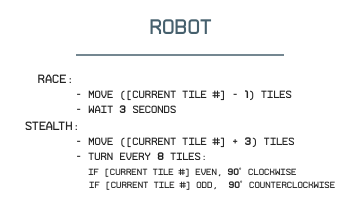


Game Variations:
Race:
The Rules:
All players are given a game card and a paper ball (if enough players then two paper balls).
Players are to keep their cards secret!
All players start at one side of the tile platform.
Robots:
Move number of tiles as instructed on their cards. Robots NEVER move backwards. If a robots card produces a negative or 0 number of tiles to move the robot is to stay still on this turn (move 0 tiles) and then as there next turn move forward 1 tile.
Once Robot has moved, they should wait the number of seconds specified on their cards before taking their next move.
While robots do carry paper balls, they are NOT allowed to throw them. It is best for robots to act as if they are thinking about throwing their paper ball though, so it is not obvious they are a robot.
If a robot is struck with a paper ball, they should walk backwards slowly to the start line.
Humans:
Must move forward in straight line; (can stay still on tiles).
If a human suspects another player to be a human, they throw a paper ball at them.
If a human is struck with a paper ball, they should walk backwards slowly to the start line.
End Game:
The first player to the other side of the number tile platform wins.
Stealth (Cooperative):
The Rules:
All players are given a game card.
Players are to keep their cards secret!
All robots & assassins start random positions on number tile platform.
Robots:
Move number of tiles as instructed on their cards. Robots NEVER move backwards. If a robots card produces a negative or 0 number of tiles to move the robot is to stay still on this turn (move 0 tiles) and then as there next turn move forward 1 tile. Robots should turn as their cards instruct. Robots should never move off of the number tile platform. If an edge is reached the robot should look at the tile they are currently on and turn in correct direction depending on the [current tile #]’s parity (odd or even).
Once Robot has moved, they should begin their next move (there is no waiting in this mode).
If a Robot comes within a three tile proximity to another player they should shake hands with the player. If the Robot is killed during the handshake, they should NOT react in any way and should continue moving as before. The Robot is now “Dead”.
If a Robot is asked by an Officer, “Are you alive?”. The Robot should say “Yes” if they have never be killed via a handshake during this game, and should say “No” if they have been killed via a handshake during this game. If the Robot says “No” they should walk backwards slowly to an edge of the number tile platform and then carefully exit.
If a Robot is struck with a paper ball, they should walk backwards slowly to an edge of the number tile platform and then carefully exit. The player should announce their role.
Assassins:
Assassins cans move as they wish. Their goal is to kill as many robots as possible before being killed or before the Officers use up all of their paper balls.
If an Assassin comes within a three tile proximity to another player they should shake hands with the player. If they wish to kill the player, the should tap the players wrist with a finger mid-handshake. If the Assassin is attacked by another Assassin during the handshake, they should NOT react in any way and should continue moving as before. Assassins can NOT be killed by other Assassins.
In this game mode, Assassins are acting as a giant team and are trying to kill as many robots as they can collectively.
If an Assassin is asked by an Officer, “Are you alive?”. The Assassin should say “Yes”.
If an Assassin is struck with a paper ball, they should walk backwards slowly to an edge of the number tile platform and then carefully exit. The player should announce their role.
Officers:
Officers cans move as they wish. Their goal is to kill the Assassins as quick as possible, which will in turn protect the robots.
Officers start the game with (2-4) paper balls depending on the number of Officers & Assassins in game at the moment.
If an Officer suspects a player of being an Assassin, they can throw a paper ball at them.
End Game:
Officers win if at least 50% of the Robots are alive. (Percentage alive can be changed to balance game)
Otherwise the Assassins win.
Stealth (Competitive):
The Rules:
All players are given a game card.
Players are to keep their cards secret!
All robots & assassins start random positions on number tile platform.
Robots:
Move number of tiles as instructed on their cards. Robots NEVER move backwards. If a robots card produces a negative or 0 number of tiles to move the robot is to stay still on this turn (move 0 tiles) and then as there next turn move forward 1 tile. Robots should turn as their cards instruct. Robots should never move off of the number tile platform. If an edge is reached the robot should look at the tile they are currently on and turn in correct direction depending on the [current tile #]’s parity (odd or even).
Once Robot has moved, they should begin their next move (there is no waiting in this mode).
If a Robot comes within a three tile proximity to another player they should shake hands with the player. If the Robot is killed during the handshake, they should NOT react in any way and should continue moving as before. The Robot is now “Dead”.
If a Robot is asked by an Officer, “Are you alive?”. The Robot should say “Yes” if they have never be killed via a handshake during this game, and should say “No” if they have been killed via a handshake during this game. If the Robot says “No” they should walk backwards slowly to an edge of the number tile platform and then carefully exit.
If a Robot is struck with a paper ball, they should walk backwards slowly to an edge of the number tile platform and then carefully exit. The player should announce their role.
Assassins:
Assassins cans move as they wish. Their goal is to kill as many robots as possible before being killed or before the Officers use up all of their paper balls.
If an Assassin comes within a three tile proximity to another player they should shake hands with the player. If they wish to kill the player, the should tap the players wrist with a finger mid-handshake. If the Assassin is attacked by another Assassin during the handshake, they should NOT react in any way and should continue moving as before. Assassins can NOT be killed by other Assassins.
In this game mode, Assassins are part of the team specified on their game card. Their team is trying to kill more robots collectively, than the other Assassin team.
If an Assassin is asked by an Officer, “Are you alive?”. The Assassin should say “Yes”.
If an Assassin is struck with a paper ball, they should walk backwards slowly to an edge of the number tile platform and then carefully exit. The player should announce their role.
Officers:
Officers cans move as they wish. Their goal is to kill the Assassins as quick as possible, which will in turn protect the robots.
Officers start the game with (2-4) paper balls depending on the number of Officers & Assassins in game at the moment.
If an Officer suspects a player of being an Assassin, they can throw a paper ball at them.
End Game:
Officers win if at least 50% of the Robots are alive. (Percentage alive can be changed to balance game)
Otherwise the Assassin team with the most kills win.


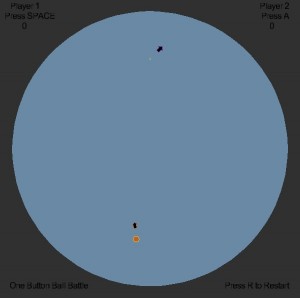








 Press”P” to change the perspective and “S’for speedup, “D”for speed down. The “monster” will eat and grow larger and faster. When it grow larger than the screen window, it will end up with a”Game Over”.
Press”P” to change the perspective and “S’for speedup, “D”for speed down. The “monster” will eat and grow larger and faster. When it grow larger than the screen window, it will end up with a”Game Over”.




